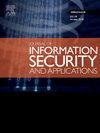D2DSec:一种有效的量子安全认证方案,用于5G网络中设备对设备通信的安全覆盖
IF 3.7
2区 计算机科学
Q2 COMPUTER SCIENCE, INFORMATION SYSTEMS
Journal of Information Security and Applications
Pub Date : 2025-08-04
DOI:10.1016/j.jisa.2025.104178
引用次数: 0
摘要
5G网络中的设备到设备(D2D)通信提供了近距离设备之间的直接交互,绕过了用户数据传输对5G网络基础设施的需求。这种方法通过减少5G核心网的流量、扩大覆盖范围和最小化通信延迟来提高网络性能。D2D通信根据网络的覆盖范围分为三个用例场景:内覆盖、中继覆盖和外覆盖。在覆盖场景中,两个通信设备都在网络的覆盖区域内运行。随着D2D通信得到越来越多的关注,对安全身份验证和密钥协议方案的需求变得至关重要。虽然公钥基础设施(PKI)解决方案,如RSA和ECC,被广泛使用,但它们很容易受到量子攻击,特别是肖尔算法。为了解决这个问题,我们提出了一个轻量级的身份验证和密钥协议方案。该提议的意义在于,它通过利用对称密钥技术和SHA3-512哈希函数增强了对量子攻击的抵抗力,提供了对Grover算法的鲁棒性,并避免了与Shor算法相关的漏洞。鉴于量子计算的快速发展,这确保了更高水平的安全性,以应对新出现的量子威胁。通过BAN逻辑和AVISPA的验证证实了该方案对各种威胁的弹性,而性能分析则强调了其以最小的计算和通信开销实现的效率。这些设备的计算开销对于Arduino Uno Rev 3为931.04 ms,对于ESP8266为37.14 ms,对于Raspberry Pi 4为2.96 ms,而通信开销被测量为7920位。本文章由计算机程序翻译,如有差异,请以英文原文为准。
D2DSec: An efficient quantum-safe authentication scheme for secure in coverage Device-to-Device communication in 5G networks
Device-to-Device (D2D) communication in a 5G network offers direct interaction between devices in close vicinity, bypassing the need for 5G network infrastructure for user data transmission. This approach enhances network performance by reducing traffic on the 5G core network, extending coverage, and minimizing communication latency. D2D communication is classified into three use-case scenarios based on the network’s coverage: In-coverage, Relay coverage, and Out-of-coverage. In the In-coverage scenario, both communicating devices operate in the network’s coverage area. As D2D communication gains increasing attention, the need for a secure authentication and key agreement scheme becomes paramount. While public key infrastructure (PKI) solutions, such as RSA and ECC, are widely used, they are vulnerable to quantum attacks, particularly Shor’s algorithm. To address this challenge, we propose a lightweight authentication and key agreement scheme. The significance of the proposal is that it enhances resistance to quantum attacks by leveraging symmetric key techniques and the SHA3-512 hash function, offering robustness against Grover’s algorithm and avoiding vulnerabilities associated with Shor’s algorithm. This ensures a higher level of security in anticipation of emerging quantum threats, given the rapid advancements in quantum computing. Validation through BAN logic and AVISPA confirms the scheme’s resilience against various threats, while performance analysis highlights its efficiency with minimal computation and communication overhead. The computation overhead of the devices is measured at 931.04 ms for the Arduino Uno Rev 3, 37.14 ms for the ESP8266, and 2.96 ms for the Raspberry Pi 4, while the communication overhead is measured to be 7920 bits.
求助全文
通过发布文献求助,成功后即可免费获取论文全文。
去求助
来源期刊

Journal of Information Security and Applications
Computer Science-Computer Networks and Communications
CiteScore
10.90
自引率
5.40%
发文量
206
审稿时长
56 days
期刊介绍:
Journal of Information Security and Applications (JISA) focuses on the original research and practice-driven applications with relevance to information security and applications. JISA provides a common linkage between a vibrant scientific and research community and industry professionals by offering a clear view on modern problems and challenges in information security, as well as identifying promising scientific and "best-practice" solutions. JISA issues offer a balance between original research work and innovative industrial approaches by internationally renowned information security experts and researchers.
 求助内容:
求助内容: 应助结果提醒方式:
应助结果提醒方式:


